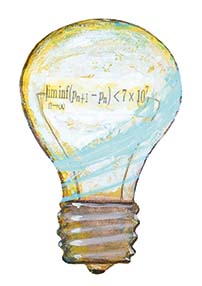 |
 |
| current issue |  |
past issues |  |
send a letter/news |  |
address update |  |
advertise |  |
about us |  |
alumni home |
Prime Time
Page 2 of 3
Previous | Next
At UNH, Zhang became a familiar sight in the corridors of Kingsbury Hall—and the stairways, where he would frequently take breaks for exercise—at all hours of the day and night. Colleagues knew he was working on "big problems," but didn't always know which ones. "I'd sometimes ask 'How's it going?'" says math professor Kevin Short. "But when you're working on hard problems, most of the time you're stuck—so you don't want to ask too often." It's been easier to live a life of single-minded devotion to centuries-old problems in the United States, Zhang believes, than it would have been in China, where the pull of familial and societal obligations is much stronger. "Not being in a political situation, you can choose your way to live here," he explains. "If you like to be quiet, keep just to yourself, that's OK. Although you have to be responsible for your choice, you have many choices. This is why I love to be in this country." In 2009, Zhang turned his focus to a problem many mathematicians—including Zhang—believe will likely never be solved with present-day mathematical tools. For two millennia, mathematicians have believed, but been unable to prove, the Twin Prime Conjecture, which states that there are infinitely many pairs of prime numbers with a difference (a gap) of 2, such as 3 and 5 or 11 and 13 or 17 and 19. Like individual prime numbers (a prime is a number greater than 1 that is divisible only by itself and 1), these "twin primes" come frequently at the start of the number line but become sparser and sparser farther along. The largest pair of twins discovered so far is 3,756,801,695,685 x 2 666,669 -1 and 3,756,801,695,685 x 2 666,669 +1. Zhang believed the way to make progress on the conjecture was through modifications to a mathematical tool called a "sieve," which uses calculations to "strain out" the nonprimes in a group of numbers. His goal—also believed by many to be unachievable—was to set aside the unattainable limit of 2 and prove that there are infinitely many prime pairs that differ by less than any numerical limit at all. Wherever he went—riding the bus from Dover to Durham, walking in the woods, climbing the stairs—the problem of limiting, or "bounding," the gaps dogged him. For him, this topic was a friendly dog, a welcome companion. Some small advances even came to him in his dreams. Still, for three years he didn't get very far. In July 2012, when Zhang was on vacation visiting a friend in Colorado, he went outside one afternoon, hoping to catch sight of some deer. No deer appeared, but his mind wandered back to the problem of bounding the gaps, and in a flash of insight, he thought of a way to modify the sieve. Ironically, and for reasons that few among us can fathom, his technique succeeds in part by making the sieve less effective at straining out closely spaced primes. He knew instantly that it would work. Months went by before Zhang chose to tell anyone other than his wife, Helen, that he thought he had a solution to the problem of bounding the gaps. His proof—showing that there are infinitely many pairs of primes with a gap of no more than 70 million—has been called a "weak" form of the Twin Prime Conjecture, and yet it is considered a huge advance. The response of the mathematical establishment was swifter and more powerful than Zhang—who had had an inkling that he might someday become famous in a mathematical sort of way—could have imagined. He submitted a draft of an article on his proof to the journal Annals of Mathematics on April 17. (That same day, Kevin Short went to the hospital to tell Ken Appel, who was gravely ill, the good news that the colleague he'd worked hard to hire and retain had made a major breakthrough. Appel died two days later.) Although word on acceptance of an article by the prestigious journal typically takes a year or two, Zhang heard from the editors just three weeks later, on May 9. |
blog comments powered by Disqus


